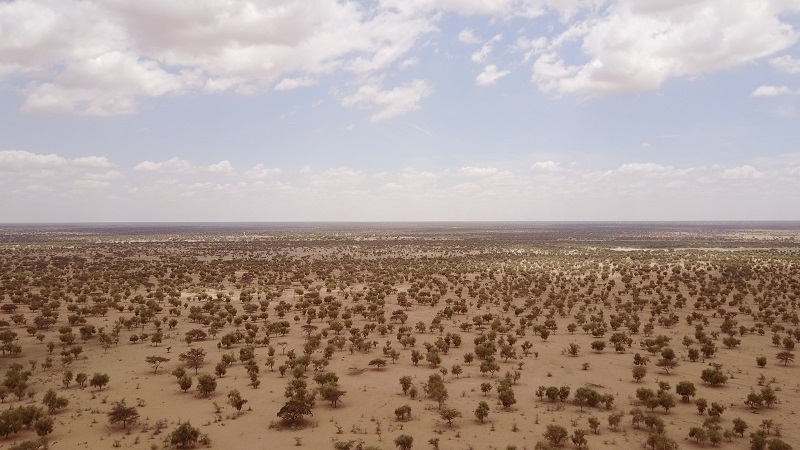An initiative to create a green corridor across Africa is key to the recovery from the coronavirus pandemic, ministers have said.
Ministers from 11 African countries in the Sahel region met virtually on Monday to take stock of progress in implementing the Great Green Wall, an ambitious vision to create a 15 kilometre wide and 8,000 kilometre long strip of vegetation across Africa.
In recent decades, severe droughts and overgrazing have turned the edge of the semi-arid Sahel – one of the poorest regions in the world – into a desert. Launched in 2007, the Great Green Wall aims to reverse the trend.
But the initiative’s first comprehensive status report found the pace of land restoration needs to more than quadruple over the next decade to meet its goal of restoring 100 million hectares of land and creating 10 million green jobs.
In a statement, ministers from Burkina Faso, Djibouti, Eritrea, Ethiopia, Mali, Mauritania, Niger, Nigeria, Senegal, Sudan and Chad said the initiative was “one of the levers for achieving the post-Covid economic recovery”.
“Now is the time to reinvigorate the Great Green Wall to stimulate the economy that has been ravaged by the pandemic,” Nigerian environment minister Mohammad Mahmood Abubakar told reporters in a press conference. Nigeria, he said, had committed additional funding to the imitative as part of its recovery package.
The ministers called on the private sector to “significantly contribute” to implementing the initiative and for the support of international organisations such as the Green Climate Fund, the Global Environment Facility and the African Development Bank Group.
Countries promise green recovery at Japanese virtual summit, keep quiet on fossil bailouts
The progress report by French firm Climatekos found that, since 2007, nearly 18 million hectares of land have been restored in the wider Sahel region, with around two thirds of that located in Ethiopia. That is expected to store an estimated 300 million tonnes of carbon in the soil and in woody biomass to 2030.
However, most of the restored land is located outside the Great Green Wall demarcation area. Only 4 million hectares of the 154 million hectares of the Great Green Wall’s intervention zone have so far been restored – accounting for only 4% of the 2030 target to restore 100 million hectares of land.
Progress on other objectives is also falling behind. In the decade to 2018, the report found the initiative generated $90 million of revenues and created 335,000 direct and indirect jobs in agriculture and pastoral activities, water and soil conservation – meeting just over 3% of 2030 objective.
Amina Mohammed, deputy secretary general of the United Nations, said the Great Green Wall should have yielded more results in the 13 years since the initiative has been running.
“This has been a great initiative that has not seen the investments that we should have had,” she told reporters.
“The Great Green Wall is a huge economic corridor of opportunity… it provides the solution to properly respond and recover” from the economic fallout of Covid-19 “by turning this time of crisis into a time of large-scale investments,” she said. She added the UN would help leverage funding from other international partners.
Climate news in your inbox? Sign up here
Jonathan Davies, global drylands coordinator at the International Union for Conservation of Nature (IUCN), told Climate Home News the high-level backing for reversing land degradation was “remarkable”. “Now the trick is to translate that political support into action. There is an opportunity to act now,” he said.
To achieve the Great Green Wall’s 2030 goals, the report found that 8.2 million hectares needed to be restored every year at a cost of up to $4.3 billion annually.
“These are enormous amounts,” said Louis Perroy, partner at Climatekos and author of the report. Insufficient coordination at the regional and national levels, concerns about tree survival rates and a lack of funding from the private sector are barriers to progress, he said.
Speaking to reporters ahead of the ministerial event, Perroy said funding had been “overall insufficient and unpredictable” with 90% of the money committed so far coming though international organisations and only 10% from member states.
“There is a need to go beyond traditional grant-based, short-term development intervention. It is also important to slowly get the private sector involved,” he said.
Loopholes in Arctic heavy fuel oil ban defer action to the end of the decade
Security is a concern in large parts of the Sahel, including in Mali, which together with Niger accounts for half of the Great Green Wall’s total area. In Mali, soldiers ousted president Ibrahim Boubacar Keita last month amid escalating violence in the country’s north.
Nigerian minister Abubakar added that the lack of jobs and economic opportunities for young people in the Sahel made them more likely to be recruited by extremists groups.
To address security issues, Marieme Bekaye, Mauritania’s minister of the environment, said the Great Green Wall needed to become part of the economic strategy of each Sahel countries and a national priority.
“The challenge to implement the Great Green Wall is to integrate it in all sectors… at the international, national and regional level. We really need to stop working in silos,” she said.
